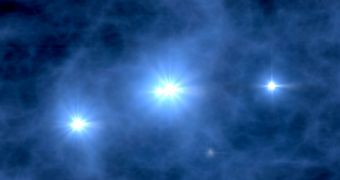The long-held idea that the first stars in the Universe were lone wolves may not be true at all, the results of a new study show. In fact, it could be that the earliest stars to shed light on the Cosmos had numerous companions around themselves.
These so-called companions may have developed when the original gas disks from which the stars developed broke apart. As this happened, fragments of them coalesced into smaller stars, that began orbiting their larger siblings.
This scenario was revealed in a computer simulation that was carried out by German researchers with the Center for Astronomy at the Heidelberg University and at the Max Planck Institute for Astrophysics. The experts worked with American colleagues at the University of Texas.
In order to understand how the earliest stars formed, a little lesson on stellar formation is in order. New stars are born from molecular clouds containing mostly hydrogen gas. Whether a new celestial fireball is born or not depends entirely on the outcome of a battle between gravity and pressure.
As the gas clouds increase in volume, their gravitational pull increases their density, which in turn raises temperature levels considerably. But when heat increases, so that the pressure the cloud exhibits.
When the pressure is too high, the compression (mass accretion and density rise) stops, and the cloud no longer grows in density and mass. The protostar can only continue on its road to first ignition when the cloud in which it originates loses thermal energy, so that compression can continue.
If chemical elements such as carbon and oxygen exist in the gas cloud, cooling occurs rapidly. The thing is that the clouds from which the earliest stars appeared did not contain these elements, as they appeared much later on in the history of the Universe, Daily Galaxy reports.
What Heidelberg astrophysicist Paul Clark and his team showed was that the accretion disk which forms around a new star may not always be capable of transporting all the mass it receives into the new star. When its accretion capacity is exceeded, the disk breaks apart in fragments.
If these fragments are large enough, they give rise to individual stars, forming small clusters. So, rather than having a single cloud forming a massive star, we now get several smaller ones, possibly comparable in mass to our own Sun.
But the new study also has some interesting implications. “Intriguingly, some low-mass primordial stars may even have survived to the present day, allowing us to probe the earliest stages of star and galaxy formation right in our own cosmic backyard,” Clark explains.

 14 DAY TRIAL //
14 DAY TRIAL //